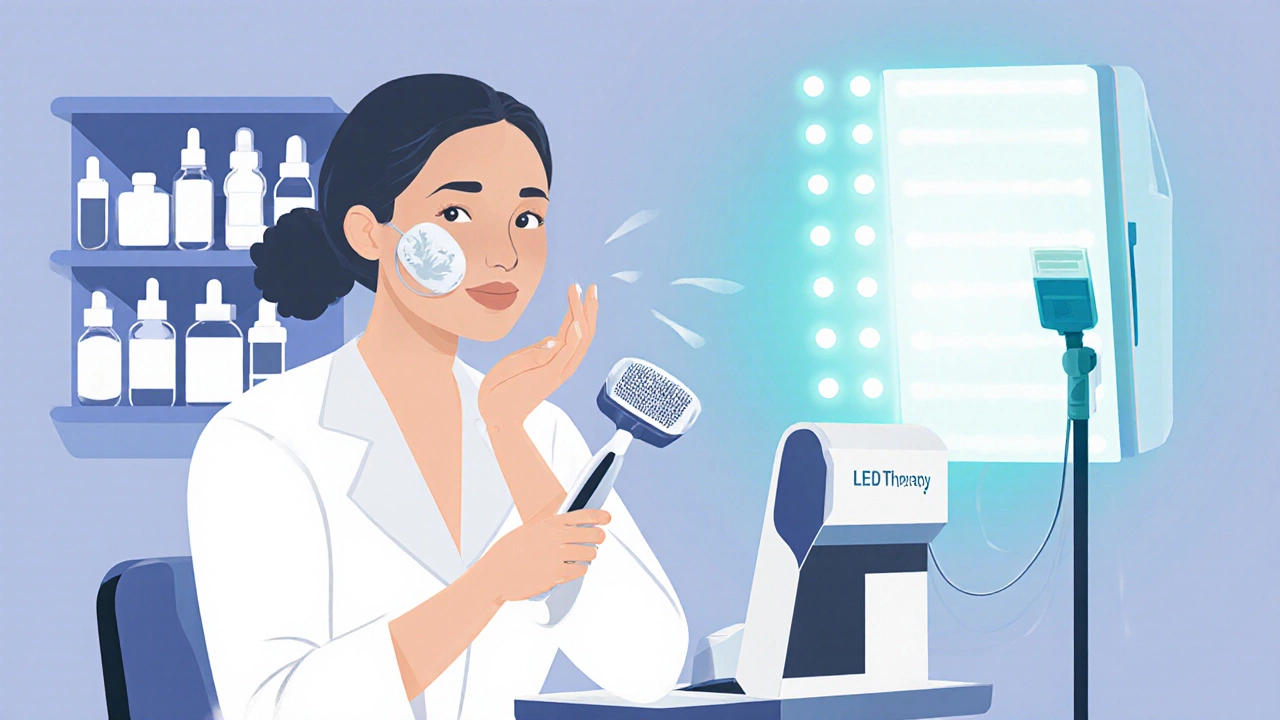
Professional Skincare Cost Calculator
Calculate Professional Skincare Costs
When you stare at the price tag of a facial or a laser session, the first thought is usually, “Is it really worth it?” The answer isn’t a one‑size‑fits‑all. It depends on what you expect, how your skin reacts, and whether you treat the investment as short‑term pampering or long‑term health care.
Professional Skincare is a suite of services and products administered by licensed dermatologists, estheticians, or trained technicians. These offerings range from clinical-grade chemicals to high‑tech devices, all aimed at treating skin conditions that over‑the‑counter (OTC) products can’t fully address. Below we break down the core components, typical costs, measurable benefits, and practical tips to help you decide if the extra spend makes sense for you.
What Exactly Falls Under Professional Skincare?
Professional skincare isn’t just a fancier version of your nightly routine. It usually includes:
- Chemical Peels - acids applied to exfoliate deeper layers, stimulating collagen.
- Microdermabrasion - a mechanical sanding that smooths texture and reduces fine lines.
- LED Light Therapy - specific wavelengths that calm inflammation or boost collagen.
- Prescription‑strength topicals (e.g., tretinoin, hydroquinone) formulated by Dermatologists or Estheticians after a skin analysis.
- Advanced device treatments such as radiofrequency, ultrasound, and laser resurfacing.
Each service targets a specific issue-hyperpigmentation, acne, aging, or rosacea-using strengths that OTC formulas simply can’t match.
How Much Does It Cost?
Pricing varies widely by location, provider expertise, and treatment type. Here’s a quick snapshot of typical Auckland rates in 2025 (prices will differ elsewhere):
- Basic facial (30‑45 min) - NZ$80‑120
- Chemical peel (medium depth) - NZ$150‑250
- Microdermabrasion session - NZ$130‑200
- LED Light Therapy package (5 sessions) - NZ$250‑400
- Laser resurfacing - NZ$1,200‑2,500 per session
- Prescription topical regimen - NZ$70‑150 per month
Many clinics bundle services, offering a “starter package” that can bring the average cost per visit down to around NZ$120‑150. If you’re budgeting, factor in follow‑up appointments-most results need 3‑6 sessions spread over weeks or months.
What Are the Real Benefits?
Numbers speak louder than anecdotes. A 2023 study published in the *Journal of Cosmetic Dermatology* compared clinical outcomes of professional chemical peels versus 5% glycolic acid creams. Results showed a 45% reduction in melasma darkness after three professional sessions, versus only 12% with the cream.
Other documented advantages include:
- Deeper Penetration: Clinical‑grade acids (e.g., trichloroacetic acid 15-20%) reach the papillary dermis, triggering more robust collagen synthesis.
- Precision Targeting: Devices like laser systems can focus on specific lesions without affecting surrounding skin.
- Faster Results: Most clients notice visible improvement after 1‑2 treatments, whereas OTC solutions often need 8‑12 weeks.
- Long‑Term Savings: By preventing premature aging, you may delay costly surgical procedures (e.g., facelift) that can cost NZ$15,000‑20,000.
- Professional Guidance: A qualified dermatologist can spot hidden conditions (e.g., early melanoma) that a DIY routine would miss.

Potential Drawbacks and Risks
Professional treatments aren’t risk‑free. Common concerns include:
- Temporary redness, peeling, or swelling-usually resolves within a week.
- Rare complications like post‑inflammatory hyperpigmentation, especially in darker skin tones if the provider doesn’t adjust protocols.
- Higher upfront cost compared to a drugstore regimen.
- Time commitment for multiple visits.
Choosing a reputable clinic and ensuring the practitioner has appropriate certifications (e.g., NZ Certified Dermatologist or Registered Esthetician) dramatically lowers these risks.
How to Decide If It’s Worth It for You
Ask yourself these three questions:
- Do I have a specific skin issue that OTC products haven’t fixed? Persistent acne, stubborn melasma, or deep wrinkles often need clinical intervention.
- Am I prepared for a short‑term commitment? Most effective protocols require 3‑6 sessions plus home care.
- Can I afford the cost without compromising essential expenses? If the treatment fits within your discretionary budget, the long‑term skincare payoff can be worthwhile.
If you answered “yes” to at least two, professional skincare is likely a smart investment.

Tips for Getting Maximum Value
- Start with a thorough skin analysis. A qualified practitioner will map out your skin type, concerns, and a personalized plan.
- Combine in‑office treatments with at‑home maintenance. Use the same active ingredients (e.g., retinol, hyaluronic acid) prescribed by your clinician to prolong results.
- Ask about package discounts. Many clinics reduce per‑session price when you book a series upfront.
- Check credentials. Verify the practitioner’s licence on the New Zealand Health Practitioners Competence Assurance (HPCA) website.
- Read reviews. Look for consistent positive feedback on results, not just ambiance.
Professional vs. Over‑the‑Counter: Quick Comparison
| Aspect | Professional Skincare | OTC Products |
|---|---|---|
| Active ingredient strength | Often 2‑10× stronger (e.g., TCA 15%) | Limited to FDA/Health‑NZ approved concentrations |
| Customization | Tailored to individual skin analysis | One‑size‑fits‑all formulas |
| Speed of results | Visible changes in 1‑2 sessions | 4‑12 weeks for modest improvement |
| Risk level | Controlled by trained professional | Low, but limited efficacy |
| Cost per treatment | NZ$100‑2,500 (depends on modality) | NZ$10‑80 for a product |
Bottom Line: Is It Worth It?
Professional skincare delivers results that many people can’t achieve on their own. If you have a clear skin concern, can commit to a short series of treatments, and have the budget for it, the investment often pays off-in smoother skin, fewer future procedures, and confidence that comes with looking your best.
On the flip side, if you’re happy with the modest improvements of a good OTC routine and have no pressing skin issues, sticking to over‑the‑counter products may be the smarter spend.
Ultimately, think of professional skincare as preventive medicine for your face. Just as you’d see a doctor for a recurring cough, a dermatologist or licensed esthetician can spot and treat problems before they become costly or permanent.
How many sessions are usually needed for noticeable results?
Most clients see a visible difference after 2‑3 sessions of chemical peels or microdermabrasion. For deeper rejuvenation (e.g., laser resurfacing), a series of 3‑5 treatments spaced 4‑6 weeks apart is typical.
Are there any skin types that should avoid professional treatments?
Individuals with active infections, severe eczema, or uncontrolled rosacea should consult a dermatologist first. Certain procedures (like deep peels) may also be toned down for very dark skin tones to prevent hyperpigmentation.
Can I combine different professional treatments?
Yes, many clinics design hybrid protocols-e.g., a mild peel followed weeks later by LED therapy. The key is to let your skin heal between sessions and follow the practitioner’s timeline.
How do I verify a practitioner’s credentials?
Check the Health Practitioners Competence Assurance (HPCA) register for dermatologists or the Registered Skin Therapists board for estheticians. Reputable clinics also display licences on their websites.
Is there a way to reduce the overall cost?
Many clinics offer package discounts, loyalty programs, or seasonal promotions. Asking about a bundled home‑care kit (prescribed serums, moisturizers) can also extend results without extra office visits.